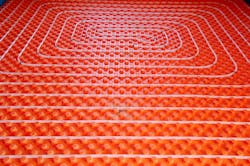In last month’s column, we discussed individual zoning controls. We continue the discussion this month.
As previously discussed, it is entirely possible to have each room as an individual zone if the customer’s needs dictate it and the budget is taken into consideration. There is a new class of control systems making its debut into the residential and light commercial arena. Although this control system has been proven in the commercial and industrial markets, it is fairly new to the residential and light commercial markets.
This “new” residential logic is a personal computer-based control system that uses the Internet for control and communications. The actual control panel is typically centrally located, usually in the main mechanical room. If there are multiple mechanical rooms, the logic can be divided between the applicable mechanical rooms. These controls can be configured and programmed to provide comfort control, security and lighting controls, all from one panel and one PC.
The installation will require the setting of remote temperature, humidity and other sensors. Conventional (18 Ga) low voltage thermostat wiring is used, and a number of wireless sensors that are compatible with these controls are making their way into the systems. As previously noted, this Internet-based logic will require a stable, secure connection to the Internet.
If cable reliability is a problem, as it can be in remote situations, it may be necessary to modify the control’s programming logic to avoid getting nuisance alarms due to a lack of communication. It is referred to as a “heartbeat,” and is typically monitored by a remote server. If a heartbeat is not received in a timely manner, then the remote server sends out an email or text telling you one was not received. This may be due to an Internet outage, or possibly a power failure at the remotely controlled sight. In any case, it is important to know.
These controls are only limited by one’s imagination, and they also bring a new distinct advantage to control logics that previously were only a dream. Having the ability to anticipate major changes in weather patterns allows the control logic the ability to anticipate drastic changes in weather elements that will have deleterious affects on the comfort of the occupants of the building. If a fast-approaching cold front is sensed based on reliable information (NOAA or U.S. Weather Bureau typically), then the system’s parameters for outdoor reset control can be shifted upward to compensate for the incoming cold weather.
Conversely, if a fast-moving hot front is approaching, and the system is being used to control radiant cooling, again, the reset schedule that is used to dictate chilled water temperatures can also be reset downward to anticipate increased demands for cooling in these applications.
As it pertains to controlling snowmelt systems, it is possible to downsize the physical plant required for melting snow because of the ability to take a slab out of “off” mode and place it in an “idle” condition in anticipation of snowfall occurring in the near future. Once moisture is detected at the point of control (slab), the controls will move the system into the “melt” mode. By anticipating this change, the thermal capacity of the snowmelt system can be reduced because the “pickup” factor can be taken out of the equation, resulting not only in significant reductions in physical plant sizing, but also the elimination of waste associated with hot idle conditions. But we digress.
These controls, although more expensive than some of the WiFi thermostat options available on the market, give the ability to control not only the zone control devices, but also the heating and cooling sources. They also enable the programmer to include certain alarms that normally could only be monitored and controlled on site.
This gives you, the service contractor, the ability to anticipate trouble before it becomes crisis management. Imagine calling a customer and telling him/her that the system sent you a distress e-mail or text, and that your company needs to come by and correct a situation before they run out of comfort or DHW. You will be a hero in their eyes.
My point with this series of articles is to point out that your options, as they pertain to controlling these highly efficient comfort delivery systems, has changed significantly over the past few years. It is important that contractors be aware of these changes, and become familiar with their abilities and associated installed costs.
Certainly, a person could stick with the proven logic of bang-bang, wall-mounted thermostats, but by increasing your knowledge and application potentials, you can upsell consumers with features for their comfort system that really tickles their fancy and make your systems that much more reliable.
Tune in next month as I help you continue to evaluate your options in delivering good, efficient radiant comfort from alternative surfaces using state-of-the-art controls. Next up: high-efficiency heat sources. In the meantime, Happy New Year from the Radiant Professionals Alliance! Do something good to start the year, and join our organization. Please visit www.radiantprofessinalsalliance.org/join.
All Mark Eatherton material on this website is protected by Copyright 2014. Any reuse of this material (print or electronic) must first have the expressed written permission of Mark Eatherton and CONTRACTOR Magazine. Please contact via email at: [email protected].
About the Author
Mark Eatherton
Mark Eatherton material on this website is protected by Copyright 2017. Any reuse of this material (print or electronic) must first have the expressed written permission of Mark Eatherton and CONTRACTOR Magazine.
